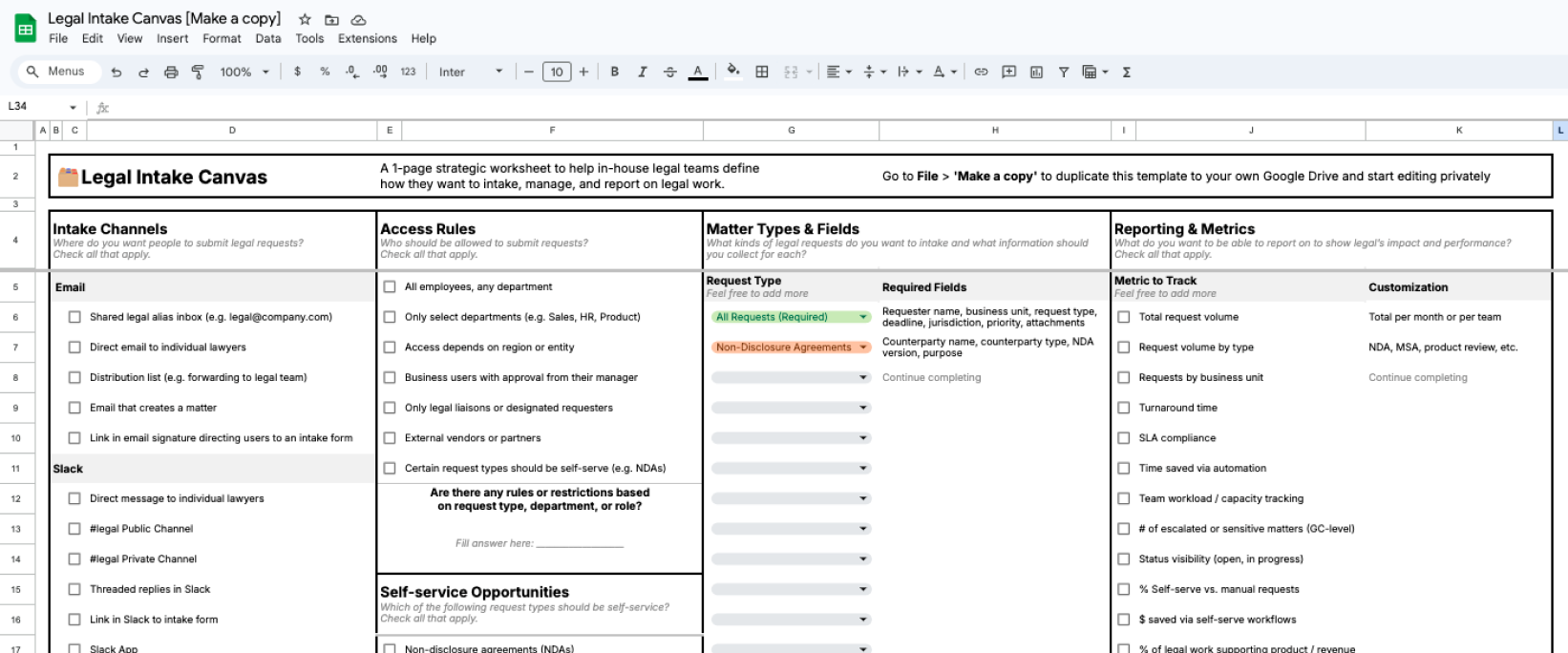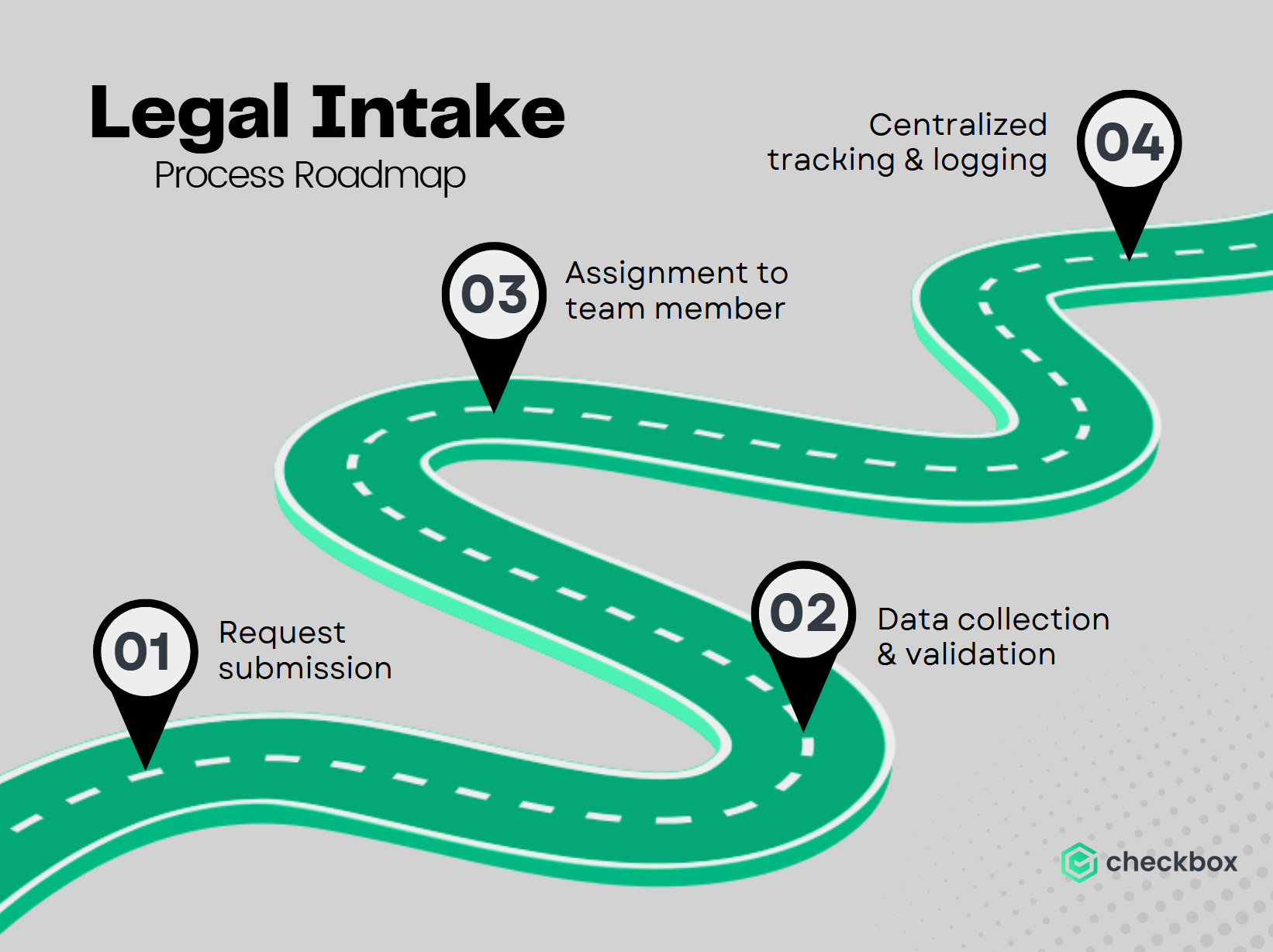Guide to Legal Intake
Reading time:
[reading time]
📄 The Legal Intake Canvas
The Legal Intake Canvas is a 1-page strategic worksheet designed to help legal teams define how they want to intake, manage, and report on legal work. It guides you through key decisions around intake channels, routing, matter types and reporting needs so you can map out a scalable, efficient intake process in under 15 minutes. Download the Legal Intake Canvas Template here or click any of the images below.


What is Intake in the Legal Context?
For in-house legal teams, intake is arguably one of the most important processes to get right. As legal teams face growing volumes of work - from contract reviews to compliance inquiries and internal legal requests, intake serves as the foundation for an effective matter management process.
A well-designed intake process ensures that requests are organized, prioritized, and directed appropriately.
In legal terms, intake refers to… the process by which legal teams receive, evaluate, and assign incoming requests, inquiries, or matters.
At its core, intake serves as a filtering mechanism; capturing the right information upfront to ensure legal requests from internal clients are clear, actionable, and routed to the appropriate team members.
Whether it’s a contract that needs review or a compliance issue that requires investigation, the intake process provides structure for what might otherwise feel chaotic or overwhelming.
By standardizing how requests are captured and prioritized, legal intake creates a foundation for streamlined operations, helping teams stay on top of their workload and maintain alignment with organizational goals.
Key Elements of Legal Intake
An effective legal intake process is built on a few key components that work together to turn a steady stream of requests into manageable, actionable tasks:
- Gathering Initial Information
Intake begins with collecting the necessary details about a request. This could involve:
- standardized forms,
- intake interviews, or
- automated workflows
designed to capture essential data such as deadlines, scope, and priority. The goal is to ensure all critical information is obtained from internal clients from the very start.
- Assigning Matters to the Right Resources
Once a request is lodged, it’s essential to direct it to the appropriate team member. A clear assignment process prevents duplication of effort, minimizes delays, and ensures the right expertise is applied to the task.
- Centralized Tracking and Logging
Maintaining a single source of truth is crucial for effective intake. By logging requests into a centralized system, such as a matter management software, legal teams can track progress, measure performance, and ensure visibility across all matters. This tracking also provides valuable insights for future optimization.
When these elements are combined, they form a robust framework that eliminates ambiguity, prevents bottlenecks, and ensures legal teams can operate at their best.

Why Does Intake Matter for In-House Legal?
For in-house legal teams, intake isn’t an administrative task. It’s the foundation upon which effective matter management and legal operations are built. A strong intake process has a ripple effect across the entire legal function, impacting visibility, organization, and overall team performance.
One of the biggest legal intake challenges that in-house teams face is managing increasing workloads without sacrificing quality or efficiency. Smart intake for legal teams, through modes like creating a legal front door and leveraging legal triage systems, addresses this challenge by providing a streamlined way to capture and prioritize requests. This not only helps avoid bottlenecks but also ensures that urgent matters are identified and addressed promptly.
Additionally, intake using a legal intake platform supports better reporting by creating a centralized log of all requests, enabling legal teams to track progress, measure workload distribution, and demonstrate their value to the organization.
Ultimately, a well-designed intake process is critical for improving how in-house legal teams manage their growing responsibilities.
So, take a moment to assess your team’s current legal intake practices and existing key features of intake & matter systems. Are they setting you up for success? If not, it might be time to explore solutions designed to elevate your intake process.
Book a call with one of our technology consultants to see how Checkbox can help.
Frequently Asked Questions
What are the key elements to include in a legal intake form?
A strong intake form captures requester details, deadlines, matter type, scope, and priority upfront. This ensures legal has all the information it needs to act quickly and accurately.
How do you triage legal requests efficiently?
Triage works best when requests are automatically categorized by urgency, complexity, and subject matter. Smart routing ensures urgent matters are escalated quickly while routine issues flow to the right resource.
What is the best software for managing legal intake workflows?
Legal intake platforms like Checkbox create a centralized “legal front door” for capturing, routing, and tracking requests. They eliminate email chaos and provide visibility into workloads and performance.
What metrics are used to measure intake process performance?
Track volume of requests, average response and resolution times, workload distribution, and completion rates. Centralized tracking also enables reporting to show legal’s value to leadership.
What is legal intake and why does it matter?
Legal intake is the process of receiving, evaluating, and assigning legal requests in a structured way. It’s the foundation of matter management, helping teams stay organized, visible, and aligned with business goals.
What challenges do legal teams face without proper intake?
Ad-hoc intake via emails or messaging apps creates delays, duplication, and poor visibility. Without intake structure, teams struggle to prioritize, track, or demonstrate their contributions.
Book a Demo
See the New Era of Intake, Ticketing and Reporting in Action.

.svg)